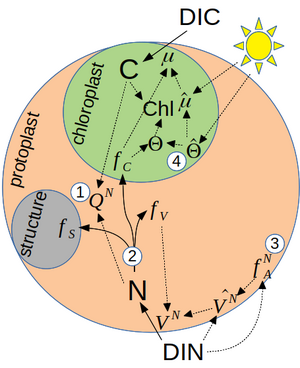Prof. Dr. Bernd Blasius
Institut für Chemie und Biologie des Meeres (ICBM) (» Postanschrift)
Physiological Flexibilities of Plankton
How does acclimation affect the carbon pump? How can acclimation be most adequately and effectively modeled?
Phytoplankton are known to be capable of rapidly acclimating to changes in environmental conditions. These acclimative responses affect the concentration of chlorophyll pigments, carbon and nutrients stored in their cells, and are therefore relevant for the global biogeochemical cycling of carbon and nutrients. Although the first experimental data were available as early as the 1960s, the theory of acclimation is far from complete and many earth system models use unrealistically simplistic descriptions of phytoplankton, and in general, primary production. The problem is that most realistic schemes attempt to resolve these acclimative flexibilities by tracking additional state variables, which lead to increasing computational costs in spatially explicit, coupled physical-biological model setups(e.g., Pahlow et al. 2013; Fig.chainmod_N_full_f4_DA).
We are developing and testing alternative model schemes in idealized (Kerimoglu et al. 2021) or more realistic 1-D, vertically resolved setups (Anugerahanti et al. 2021), where these acclimative responses can still be tracked, but without requiring additional state variables (as in Smith et al. 2016). Our model results provide insights into the relevance of these acclimative flexibilities for the emergence of patterns like deep chlorophyll maxima and ecosystem functions such as nutrient depletion rates (Kerimoglu et al 2021), as well as for the performance of coupled physical-biogeochemical models in capturing field observations in the open ocean (Anugerahanti et al. 2021).
Further Information:
Pahlow et al. (2013) Optimality-based model of phytoplankton growth and diazotrophy.
Smith et al. (2016) Flexible phytoplankton functional type (FlexPFT) model: size-scaling of traits and optimal growth.
Kerimoglu et al. (2021) FABM-NflexPD 1.0: assessing an instantaneous acclimation approach for modeling phytoplankton growth.
Anugerahanti et al. (2021) Enhancing Ocean Biogeochemical Models With Phytoplankton Variable Composition.




